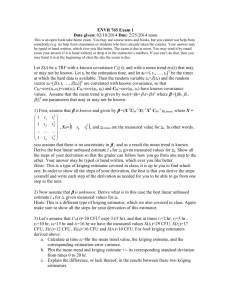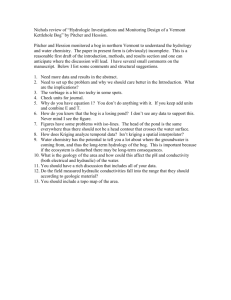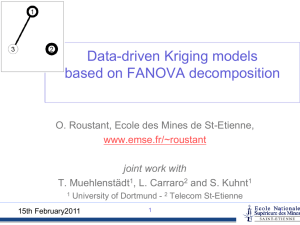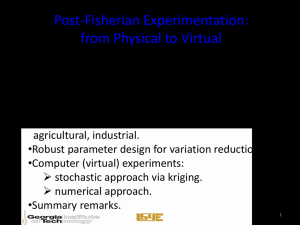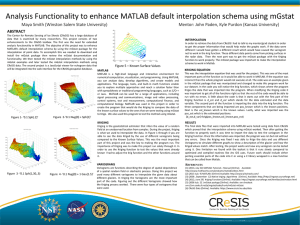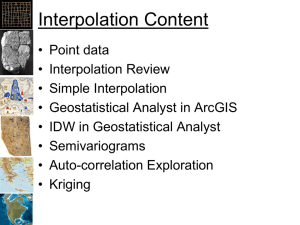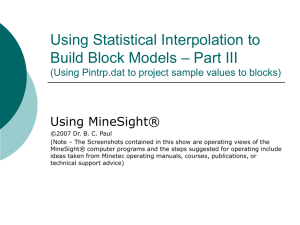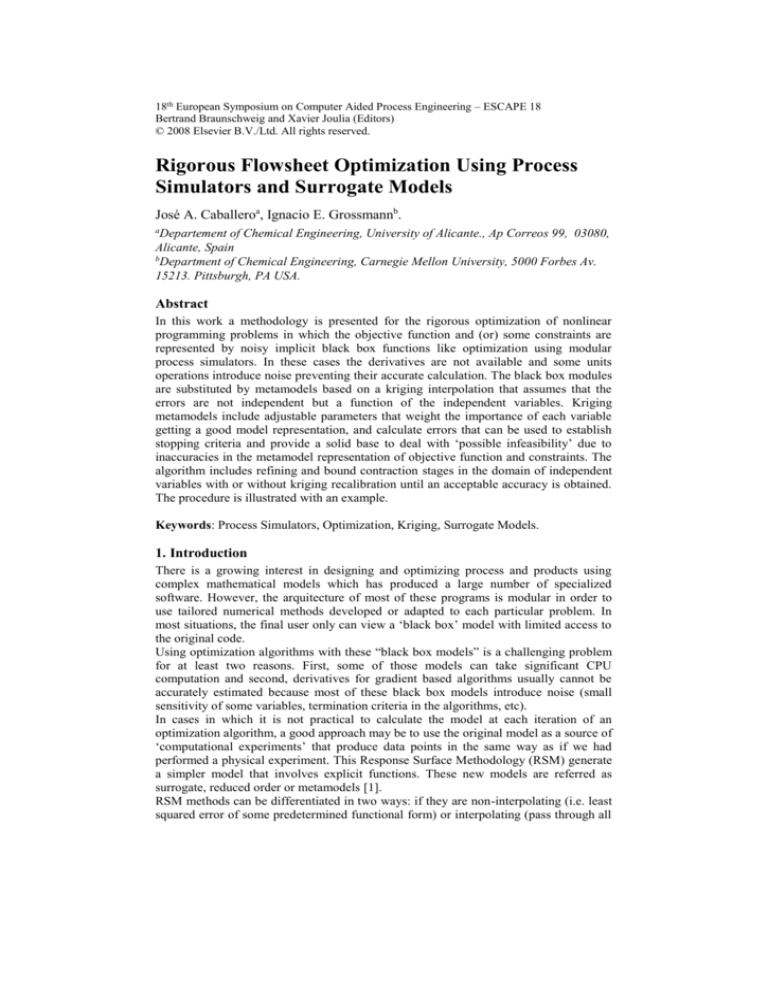
18th European Symposium on Computer Aided Process Engineering – ESCAPE 18
Bertrand Braunschweig and Xavier Joulia (Editors)
© 2008 Elsevier B.V./Ltd. All rights reserved.
Rigorous Flowsheet Optimization Using Process
Simulators and Surrogate Models
José A. Caballeroa, Ignacio E. Grossmannb.
a
Departement of Chemical Engineering, University of Alicante., Ap Correos 99, 03080,
Alicante, Spain
b
Department of Chemical Engineering, Carnegie Mellon University, 5000 Forbes Av.
15213. Pittsburgh, PA USA.
Abstract
In this work a methodology is presented for the rigorous optimization of nonlinear
programming problems in which the objective function and (or) some constraints are
represented by noisy implicit black box functions like optimization using modular
process simulators. In these cases the derivatives are not available and some units
operations introduce noise preventing their accurate calculation. The black box modules
are substituted by metamodels based on a kriging interpolation that assumes that the
errors are not independent but a function of the independent variables. Kriging
metamodels include adjustable parameters that weight the importance of each variable
getting a good model representation, and calculate errors that can be used to establish
stopping criteria and provide a solid base to deal with ‘possible infeasibility’ due to
inaccuracies in the metamodel representation of objective function and constraints. The
algorithm includes refining and bound contraction stages in the domain of independent
variables with or without kriging recalibration until an acceptable accuracy is obtained.
The procedure is illustrated with an example.
Keywords: Process Simulators, Optimization, Kriging, Surrogate Models.
1. Introduction
There is a growing interest in designing and optimizing process and products using
complex mathematical models which has produced a large number of specialized
software. However, the arquitecture of most of these programs is modular in order to
use tailored numerical methods developed or adapted to each particular problem. In
most situations, the final user only can view a ‘black box’ model with limited access to
the original code.
Using optimization algorithms with these “black box models” is a challenging problem
for at least two reasons. First, some of those models can take significant CPU
computation and second, derivatives for gradient based algorithms usually cannot be
accurately estimated because most of these black box models introduce noise (small
sensitivity of some variables, termination criteria in the algorithms, etc).
In cases in which it is not practical to calculate the model at each iteration of an
optimization algorithm, a good approach may be to use the original model as a source of
‘computational experiments’ that produce data points in the same way as if we had
performed a physical experiment. This Response Surface Methodology (RSM) generate
a simpler model that involves explicit functions. These new models are referred as
surrogate, reduced order or metamodels [1].
RSM methods can be differentiated in two ways: if they are non-interpolating (i.e. least
squared error of some predetermined functional form) or interpolating (pass through all
2
J.A. Caballero and I.E. Grossmann.
points). Jones [2] showed that non interpolating surfaces, such as quadratic surfaces, can
be unreliable because they do not capture the shape of the function. He showed that it is
usually better to use surfaces that interpolate the data with linear combinations of ‘basis
functions’ and showed some examples in which quadratic fitting could not even locate a
local minimum.
In interpolating methods it is possible to differentiate between fixed basis functions (i.e.
linear, cubic or thin-plate splins) and basis functions with adjustable parameters
(kriging). Furthermore, kriging has a statistical interpretation that allows the
construction of estimations or the error in the interpolator, which can be crucial in the
development of an accurate optimization algorithm. Due to these adjustable parameters
kriging interpolation tends to produce the better results[2,3]
In this work, we develop an algorithm based on fitting response surfaces –using a
kriging metamodel- for the optimization of constrained-noise black box models.
Besides, an important characteristic is that we deal with constrained problems in which
the metamodel can represent either the objective function or some constraints (or both
simultaneously). A typical case is the optimization of process flowsheets using modular
simulators in which some units are represented by a metamodel. In these systems it is
possible to include external constraints and even the result of some calculations could
be constraints to the model.
In the rest of the paper we first present an overview of kriging. Then an algorithm based
on successive region refinement is introduced. Finally, an example illustrates the
performance of the algorithm.
2. Overview of Kriging Interpolation
When we evaluate a deterministic function in a set of given points we assume that the
true function y(x) is approximated by a function f(x) with some error;
y ( x) f ( x)
(1)
Most metamodel techniques assume that the errors ( ) are independent and identically
distributed (with a normal distribution) ~ N (0, 2 ) x . However, the errors in the
predicted values are usually not independent, but they are a function of x. Therefore, the
kriging fitting approach is comprised of two parts; a polynomial term and a departure
from that polynomial:
y( x) f ( x) Z ( x) 1x 2 x2 Z ( x)
(2)
where Z is a stochastic Gaussian process, that represent the uncertainty about the mean
of y( x) with expected value zero E Z ( x) 0 and covariance for two points x i , x j :
cov Z (xi ), Z (x j ) 2 R(xi , x j ) . Here 2 is a scale factor known as process variance
that can be tuned to the data and R(xi , x j ) is the spatial correlation function (SCF). In
kriging fitting, when a function is smooth, the degree of the polynomial f(x) does not
affect significantly the resulting metamodel fit because Z(x) captures the most
significant behaviour of the function[1]. This is an important advantage of kriging
models. Usually a simple constant term () is enough for a good prediction.. The choice
of SCF determines how the model fits the data. There are many choices for the SCF, but
the most common used in kriging models is the exponential function:
Rigorous Flowsheet Optimization Using Process Simulators and Surrogate Models
d
R xi , x j exp l xi ,l x j ,l
l 1
l 0; 0 Pl 2
Pl
3
(3)
To estimate the values of , 2 ,l , Pl , we maximize the logarithm of the likelihood of
the observed data y. The optimal values of and 2 can be obtained analytically.
1T R 1y
1T R 11
2
;
(y - 1 )T R 1 (y - 1 )
;
n
(4)
Parameters l , Pl can be obtained by maximizing the concentrated log-likelihood
function:
2
n
1
max ln( ) ln R
l , Pl
2
2
(5)
The final predictor for the new point
x
new
, y new
and its mean squared error in the
kriging interpolation is given by equations 6 and 7. A detailed derivation can be found
in Sasena [4]
y xnew rT R 1 y 1
2
(1 rT R -1r )2
s 2 ( x new ) 1 rT R -1r
1T R -11
(6)
(7)
There are two important differences between kriging and other basis function methods
that made that kriging usually outperforms those methods. First, other methods usually
do not have parameters in their basis functions, or if there is any parameter this is rarely
optimized. Second, most of the methods use a Euclidean norm which makes them
sensitive to the units of measurements. Kriging, however, capture all those effects in the
’s parameters through a non-Euclidean norm.
3. An algorithm for process flow-sheets optimization using kriging
metamodels
Although the algorithm described in next paragraphs is described for optimizing process
flowsheets, it can be used for any black box model with or without noise. It guarantees a
local minimum within a pre-specified tolerance.
1. Selection of the implicit models to be substituted by a kriging metamodel. Given a
flowsheet to optimize, identify the unit operations that introduce noise or are very
CPU time consuming in simulation. These will be the units to be substituted by a a
kriging model. And estimate the noise introduced by dependent variables (especially
if the noise introduced is important). Note that the accuracy of the final optimum
point cannot be higher than the noise, but should be as close as possible.
2. Sampling. Select the domain of the independent variables for the sampling, and
select an initial confidence domain for those independent variables. Inside the
domain sample in N distributed points.
4
J.A. Caballero and I.E. Grossmann.
3. Fit all the surfaces using kriging and validate the model. Once all the variables
(surfaces) have been estimated by kriging, it is important validate the metamodel, i.e.
using ‘cross validation’ that allows us to asses the accuracy of the model without
extra sampling [2]. A kriging model can be considered correct if all the errors in
cross validation are inside the interval [-3,+3] standard errors.
4. Perform the optimization of the flow-sheet substituting the selected units by their
metamodel. If we are dealing with a constrained problem in which the constraints are
calculated through a metamodel, the errors introduced in the model could produce
infeasibilities. One way to deal with this problem consists of simply consider that the
problem is ‘possibly feasible’ if the infeasibilities for each equation are inside the
errors estimated by the kriging. In the refinement stage, as errors decrease, it is
possible to confirm or not this assumption.
5. Refinement without updating kriging parameters. It is possible to improve the
solution obtained in point 4 by adding this new point to the kriging model without reoptimize the parameters. With the new point added we re-optimize the model. This
re-optimization is expected to be very fast because the initial point should be near the
optimal solution. The procedure is repeated until two successive results are inside a
pre-specified tolerance.
6. . Region contraction or moving steps. Depending on where the solution of previous
step is located we take different actions that redefine the domain of independent
variables.
If the optimal solution obtained in steps 4 (or 5) is an internal point to the original
hypercube then select a contraction factor and reduce the size of hypercube. This
new hypercube is centered on the optimal solution of previous step.
If the optimal solution is in the limit of the hypercube then do not reduce the size
of the hypercube, simply move it to do that this last point be the centre of the
hypercube. The limits of the hypercube can go further than the bounds of the
variables, although the sampling is always performed inside those bounds.
Therefore a contraction step is only performed if the last point is in the boundary
of the hypercube, but not if it is only in the limit of the domain of a variable.
7. Go back to point 4 adding to the new sample the optimal point obtained in step 6.
In each contraction step a new set of sample points is generated. Previous samples are
discarded. Recall that we are looking for a local optimum, and points far away from this
optimum do not provide valuable information and considerably
3.1. Convergence of the algorithm
Once a kriging metamodel is generated, the simple substitution of this model by the
actual one does not guarantee even a local optimum. Even more, a refinement procedure
(as described in point 5 of previous section) that consist of solving the problem and
successively update the kriging with the last obtained solution until there is no
improvement in two consecutive iterations, does not guarantee a local optimum. Biegler
et al.[5] proved that a necessary condition for an appropriate simplified model for
optimization is that the gradients of the simplified and rigorous models be the same at
the optimum. This, however, implies nothing about convergence to KKT points inherent
in the simple model that may be absent in the rigorous model. Biegler et al. [5] also
proved that a sufficient condition for an appropriate simplified model is that it matches
the gradients of the rigorous model at all points. Therefore, in order to ensure a local
optimum it is not enough to add a new point but to force the gradient of the surface to
match the gradient of the true function.
Rigorous Flowsheet Optimization Using Process Simulators and Surrogate Models
Therefore, the successive contraction of the search region (step 6 in the proposed
algorithm) is introduced to guarantee a local minimum. As the domain of independent
variables decreases the kriging metamodel adjust better the actual function, and its
gradients. Besides, kriging calculate errors in the interpolated points providing an
accurate termination criteria.
In noisy systems it is not possible to verify if the gradient of the metamodel matches the
gradient of the true function. In this case the stopping criteria is based on the
assumption that if in two successive major iterations (at least one contraction must be
performed) the optimal solution is the same, we would expect that the gradients also
match the ‘true gradients’. This is only a heuristic based on the observation that, as the
domain reduces, the accuracy of the kriging increases, and also the accuracy of the
derivative information extracted from the kriging.
4. Example
The example illustrates the optimization of a divided wall column. In order to avoid
increasing the complexities of the model, we minimize the heat flow in the reboiler. A
divided wall column can be simulated using the thermodynamically equivalent
configuration Petlyuk arrangement[6] (see Figure1)
Reflux Ratio = 3.26
2201 kW
60.8 kmol/h
Mol fractions [B 0.98, T 0.016, X 0.00]
138.7 kmol/h
Benzene 60 kmol/h
Toluene 80 kmol/h
Xylene 60 kmol/h
T = 102.9 ºC
P = 101.3 kPa
Column with 26 trays
46.3 kmol/h
Tray
36
Tray
13
245.7 kmol/h
137.9 kmol/h
Tray
16
80.2 kmol/h
Mol fractions [B 0.001, T 0.95, X 0.049]
Tray 58
Column with 77 trays
59.2 kmol/h
Mol fractions [B 0.00, T 0.05, X 0.95]
2295 kW
Figure 1. . Scheme of the Petlyuk arrangement equivalent to a divided wall column
From a simulation point of view, the two thermal couples introduce two recycles. .In
this case, recycles introduces two complications: 1. Good initial values are needed to
converge the flowsheet, and 2. The time to converge the flowsheet considerably
increases. It would be possible to decompose the system in individual columns and
develop a kriging for each column, but the dimensionality of the kriging model would
be larger, because we would have to deal with the recycles explicitly. Therefore, it is
better to keep the divided wall column as an entity that can be efficiently substituted by
a kriging metamodel.
The objective is separate a mixture of 200 kmol/h of Benzene, Toluene and p-Xylene,
with molar composition (0.3, 0.4, 0.3) and obtain the pure components with at least a
recovery of 95% in each component using a divided wall column. Relevant data are
included in the Figure 1.
5
6
J.A. Caballero and I.E. Grossmann.
If the pressure is fixed, there are 5 degrees of freedom. A mass balance allows specify
the flow of distillate (D) (benzene) and intermediate product (P) (toluene) to a narrow
interval. Therefore, although the kriging metamodel depends on 5 variables two of them
can be almost fixed a priori, which increase the robustness of the model. The simulator
(Hysys.Plant) forced us to specify the liquid (L) and vapor (V) streams that are
withdraw from second column and returned to the first one. As remaining specification
we chose the reflux ratio (RR). Initial values for these last three degrees of freedom, a
reasonable interval of values as well as the number of trays of each column the feed and
products tray positions, can be estimated using a shortcut method [6]
Table 1 shows a summary of the iterations. In this example, even thought the number o
independent variables is five, the bounds of at least three of them are very close
improving the performance of the algorithm. Therefore it is not strange that in the first
iteration, the results are very close the optimal solution. The second iteration assures
that the kriging errors are inside the tolerance.
Table 1. Summary of the main steps in algorithm in example
Initial interval:
55 D 65; 75 P 85; 40 L 70; 100 V 200; 2.8 RR 4
(D, P, L, V in kmol/h)
Kriging metamodels: xB = Molar fraction of Benzene in distillate; xT = Molar fraction
of Toluene in intermediate product stream; xX = Molar fraction of Xylene in Bottoms
stream; Q = Heat flow in the reboiler (kW)
Number of sampled points = 91.
Iteration 1. Optimal values after refining
D
L
RR
61.6
42.6
3.2
P
V
79.4
134.7
Q (kW)
CPU time (s)
2295
5.82
80.2
137.9
Q (kW)
CPU time (s)
2295
21.1
Iteration 2. Optimal values after refining
D
L
RR
60.8
46.3
3.26
P
V
Total CPU time (s) = 526.9 (53.7% sampling; 40.3 kriging generation)
5. Acknowledgements
The authors gratefully acknowledge the financial support from the “Ministerio de
Educacion y Ciencia” in Spain under project CTQ 2005 – 05456.
References
[1] Papalambros, P. Y.; Wilde, D. J. Ed. Cambridge University Press Principles of Optimal
Design: Modeling and Computation. 2000.
[2] Jones, D. R.,2001, J. Glob. Optim. 21(4), 345-383.
[3] Jones, D. R.; Schonlau, M.; Welch, W. J.,1988. J. Glob Optim.1998, 13(4), 455-492.
[4] Sasena, M. J. 2002. Flexibility and Efficiency Enhancements for Constrained Global Design
Optimization with Kriging Approximations. Ph. D Thesis, University of Michigan
[5] Biegler, L. T.; Grosmann, I. E.; Westerberg, A. W.,1985,. Comput. Chem. Eng, 9(2), 201-206.
[6] Carlberg, N.A.; WesterbergA.W. 1989, Ind. Eng. Chem. Res. 28(9), 1386-1397.

